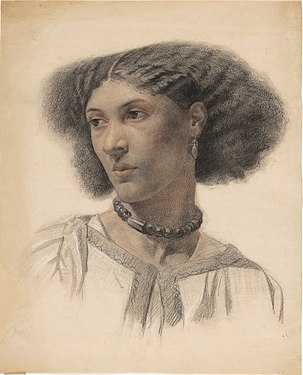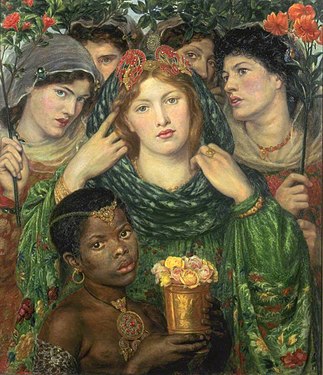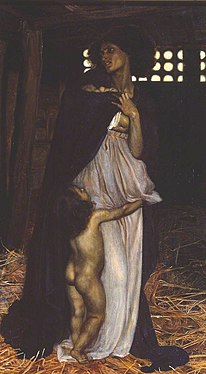Fanny Eaton
Fanny Eaton | |
|---|---|
 Portrait by Walter Fryer Stocks, ca. 1859, Princeton University Art Museum | |
| Born | Fanny Antwistle 23 June 1835 |
| Died | 4 March 1924 (aged 88) Hammersmith and Fulham, London, England |
| Nationality | Jamaican, English |
| Occupation | Art model, domestic cook |
| Years active | 1859–1867 (art model) |
| Known for | Pre-Raphaelite model |
Fanny Eaton (23 June 1835 – 4 March 1924) was a Jamaican-born artist's model and domestic worker. She is best known as a model for the Pre-Raphaelite Brotherhood and their circle in England between 1859 and 1867. Her public debut was in Simeon Solomon's painting The Mother of Moses, which was exhibited at the Royal Academy in 1860. She was also featured in works by Dante Gabriel Rossetti, John Everett Millais, Joanna Mary Boyce,[1] Rebecca Solomon, and others.[2]
Early life and family[]
Eaton was born Fanny Antwistle or Entwhistle[3] on 23 June 1835 in Saint Andrew Parish, Jamaica. Her mother was Matilda Foster, a woman of African descent, who may have been born into slavery. No father was named on Eaton's birth records, suggesting that she may have been illegitimate.[4] Eaton and her mother made their way to England some time in the 1840s. By 1851 she is recorded as living in London, with her mother, and working as a domestic servant. In 1857 she married James Eaton, a horse-cab proprietor and driver, who was born on 17 February 1838 in Shoreditch. Together, they had 10 children.
Modelling[]
It was during this period of Fanny Eaton's life as mother and new wife that she began modelling for the Pre-Raphaelites. Eaton primarily modelled out of necessity; to augment her salary as a charwoman and provide sustenance for her children. Her distinctive features were often used by artists to portray a variety of ethnicities and characters. The earliest studies done of her are pencil sketches by Simeon Solomon in 1859, and she appears to have also modelling for other artists who were Solomon's friends, including William Blake Richmond and Albert Joseph Moore.[citation needed] This includes Richmond's painting The Slave (1886), found in Tate's collection.[a]
These sketches were used as preparation for his Mother of Moses, now in the collection of the Delaware Art Museum. Two specific sketches from this series depicted Mrs Eaton as the two Biblical figures of Jochabed and Miriam. The finished painting was shown at the Royal Academy in 1860. In 1865, she was used by Dante Gabriel Rossetti for the figure of the one of the bridesmaids in his painting The Beloved.[5]
The painting Jephthah (1867) by John Everett Millais also shows Eaton standing on the right-hand side.[6]
Eaton appears in a black chalk drawing by Rossetti, now in the Cantor Arts Centre at Stanford University in California.[7]
Depictions[]

Portrait by Walter Fryer Stocks (1859)

The Mother of Moses by Simeon Solomon (c. 1860)

portrait by Simeon Solomon (c. 1860)

Head of a Mulatto Woman (Mrs. Eaton) by Joanna Boyce Wells (c. 1860)

The Young Teacher by Rebecca Solomon (1861)

The Beloved (‘The Bride’) by Dante Gabriel Rossetti (1865)

The Slave by William Blake Richmond (1886)[a]
Death[]
By 1881 Eaton had been widowed and was working as a seamstress. In the final years of her life, Eaton worked as a domestic cook on the Isle of Wight for a Portsea-based wine merchant and his wife, John and Fanny Hall. By 1911, however, Fanny is said to be residing with family in Hammersmith with her daughter Julia, son-in-law Thomas Powell and grandchildren Baden and Connie Powell. After a long life as a working-class émigrée, Fanny Antwisle Eaton died in Acton on 4 March 1924 at the age of 88 from . She is buried in Margravine Road Cemetery in Hammersmith.
Commemoration[]
In 2018, in celebration of the 100th anniversary of women's right to vote, The Voice newspaper listed Eaton – alongside Kathleen Wrasama, Olive Morris, Connie Mark, Diane Abbott, Lilian Bader, Margaret Busby, and Mary Seacole – among eight Black women who have contributed to the development of Britain.[8]
In October 2019 to January 2020, she was one of 12 women included in the Pre-Raphaelite Sisters exhibition at London's National Portrait Gallery.[9]
On 26 April 2020, an art history short about her featured in the programme hosted by BBC Radio 1 film critic Ali Plumb, Get Animated! Introducing BBC Arts[10] and also on BBC New Creatives website.[11]
To mark Black History Month in October 2020, Prima magazine named Eaton as one of six Black British women – together with Margaret Busby, Claudia Jones, Mary Prince, Lilian Bader and Olive Morris – who "changed the world".[12]
On 15 October 2020, poet Maz Hedgehog performed a poem about Eaton as part of BBC Blue Peter's Black History Month poetry segment.[13]
On 18 November 2020, she was commemorated with a Google Doodle.[14]
See also[]
- Laure (art model)
- Joseph (art model)
- Lizzie Siddal
Notes[]
- ^ Jump up to: a b The Eaton family believes that Fanny Eaton was also the model for William Blake Richmond's 1886 painting The Slave.[15]
References[]
- ^ Pina, Stephanie Graham (3 February 2014), "Image of the Week: Head of Mrs. Eaton by Joanna Boyce Wells". Pre-Raphaelite Sisterhood.
- ^ Ferrari, Roberto C., 2014, "Fanny Eaton: The 'Other' Pre-Raphaelite Model", Columbia University Academic Commons, doi:10.7916/D8X92900.
- ^ Marsh, Jan (2013). "Pictured at Work: Employment in Art 1800–1900". In Adi, Hakim; Bressey, Caroline (eds.). Belonging in Europe – The African Diaspora and Work. Routledge. ISBN 9781317989769.
- ^ Giles, Laura M. "New Acquisition: Walter Fryer Stocks's Mrs. Fanny Eaton". Princeton University Art Museum.
- ^ Marsh, Jan; Manchester City Art Gallery (2005). Black Victorians: black people in British art 1800–1900. Lund Humphries. ISBN 0853319308.
- ^ "Amgueddfa Cymru – National Museum Wales".
- ^ Surtees, Virginia (1971). The Paintings and Drawings of Dante Gabriel Rossetti (1828–1882). Oxford: Clarendon Press. pp. 204 no. 556.
- ^ Sinclair, Leah (6 February 2018), "Suffrage 100: The Black Women Who Changed British History", The Voice.
- ^ "Pre-Raphaelite Sisters". National Portrait Gallery. Retrieved 25 January 2020.
- ^ "Get Animated! Introducing BBC Arts", BBC.
- ^ "Fanny Eaton: The Forgotten Pre-Raphaelite Model", New Creatives, BBC, April 2020.
- ^ Firth-Bernard, Bryony (7 October 2020). "The Black women who were true game changers". Prima.
- ^ "Maz Hedgehog: Fanny Eaton", Black History Month: Poems##, BBC.
- ^ "Celebrating Fanny Eaton". Google. 18 November 2020.
- ^ Figes, L (23 October 2019). "Fanny Eaton: Jamaican Pre-Raphaelite muse". ArtUK.org. Retrieved 18 November 2020.
Further reading[]
- Figes, Lydia (23 October 2019). "Fanny Eaton: Jamaican Pre-Raphaelite muse". ArtUK.org
- 1835 births
- 1924 deaths
- Jamaican female models
- English artists' models
- 19th-century Jamaican people
- People from Saint Andrew Parish, Jamaica
- Jamaican emigrants to the United Kingdom
- Pre-Raphaelite Brotherhood artists' models
- Women of the Victorian era







